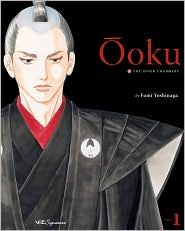Fumi Yoshinaga has masterfully invented her own genre with Ooku: The Inner Chambers. She blends an underlying science fiction premise with a bird's eye view of the intimately political and politically intimate life of a fantasy Tokugawa government and its leader, the shogun. Of course, there's a little bit of romance as well. Also, did I mention that in this world men have been reduced to a mere 1/4 of their former number thanks to a mysterious disease known as the "Redface pox"?
Ooku opens with an energetic young boy's solitary trek to the forest somehow ending with his unwittingly bringing death and disease to his village. The strange disease he unleashes upon his return somehow only effects men -- particularly young men -- and spreads quickly throughout the entire countryside. 80 years later the entire society has adapted to this strange turn of events and the male population has finally stabilized at 25% of their previous numbers. Men are precious commodities who are most prized for their role in procreation and marriage is a reality only for the rich and powerful who can afford it. Meanwhile, women have taken over in positions formerly occupied by men. They not only manage the family unit and labor, they also have taken over the business of running the country via the position of the shogun.
In this brave new world, Yoshinaga has the reader enter the Shogun's Inner Chambers -- the home of the shogun's harem of beautiful, accomplished and virile young men men -- along with Mizuno, a young man from a distinguished, but impoverished, samurai family. Mizuno is a man who freely sleeps with women in a society in which sex is bought and sold without a second thought and parents will often sell their sons' sexual innocence for their own benefit. He chooses to enter the service of the Shogun as a mere page -- practically the lowest of the low -- rather than sell himself in marriage to a woman he does not love.
The workings of the inner chamber are a mystery to the outside world, and through the introduction of the kind and honorable Mizuno we witness the scheming and dangerous culture of this shockingly harsh world of politicized sex and beauty. Men who are kept in this chamber are really no more than ornaments and it becomes obvious that in such a world the collection of a male harem -- whose members should otherwise be ensuring the continued survival of humanity -- is itself the most offensive form of luxury ever dreamt up. In response to finding themselves in this fishbowl, the men ruthlessly compete for the honor of serving the shogun intimately, and when they grow too old for that "honor," they can scheme to serve her politically. Mizuno's sense of decency and justice are challenged by this strange world. The fact he doesn't quite fit in with the culture of the inner chamber allows him to distinguish himself and somehow rise quickly through the ranks until he finds himself placed before the new shogun as a potential nighttime companion (only one of many possible choices available to her).
The new shogun -- Yoshimune --is a bit of a revolutionary in her unique way. Unwilling to accept customs merely because they have become ingrained practice, she seems to be dismantling the walls which support the inner chamber with her own two hands. Not because she has any malice for the men of the inner chamber but because she is concerned only with the ruling of her country, and, therefore, has little care for the overly orchestrated dances of the shogun's bedroom. After upending common practice with her customary bluntness (while simultaneously changing the entire course of Mizuno's life), Yoshimune begins to uncover the scent of a mystery at the heart of this age -- just how exactly did women and men come to their respective places in this society?
This work is quite spectacular on many levels -- Yoshinaga deftly weaves Mizuno's tale into a fascinating behind-the-scenes portrait of Japan's fantasy court life. Her art, always distinct, has improved to the point that one is able to decipher both the intellectual and emotional meaning of every scene. In her early works, I often felt pulled in one direction or the other. Here, her art and exposition-heavy (but never burdensome) narrative have achieved full synthesis to produce a great work of visually arresting storytelling. The adapter has brilliantly incorporated formal, almost early-Modern, English speech (think Shakespeare), allowing the reader to experience the historical setting as first a shock to the system. Eventually, through exposure, the reader should experience the formal language as naturally as breathing as one slowly becomes attuned to the rhythms of the characters' language. Finally, Viz has produced a handsome volume, with french flaps, color pages, and clear and crisp printing. All in all, this work stands as one of the best to be published in English this year and I can't recommend it highly enough.
Review Copy provided by Viz.


